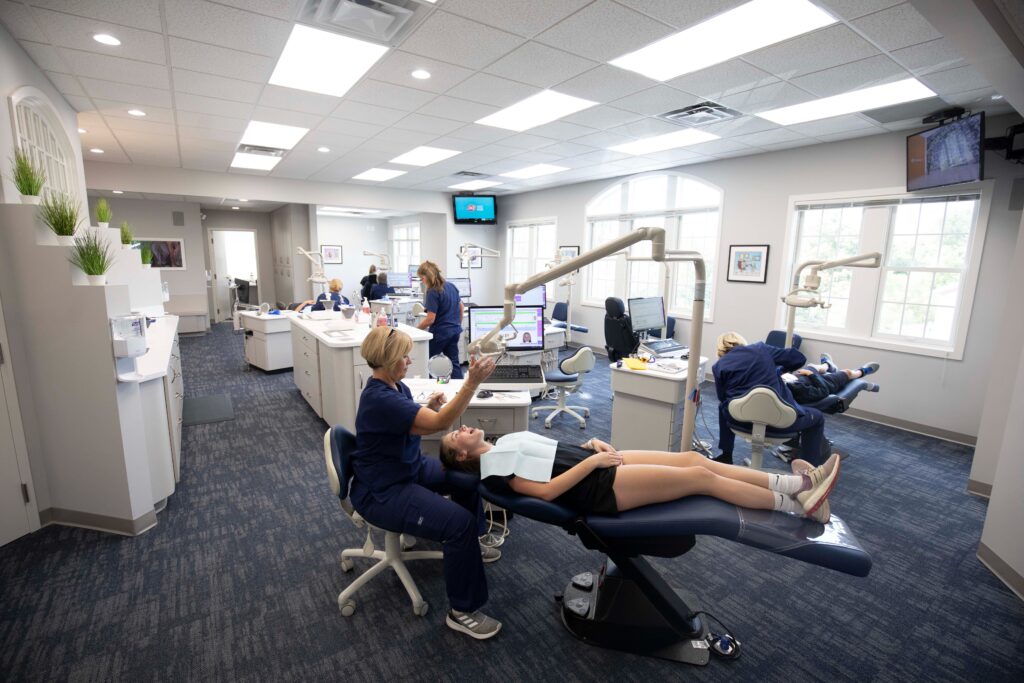Surprisingly, the optimal time for braces isn’t limited to childhood or adolescence. In reality, waiting until adulthood can be a perfectly reasonable choice. Our team at Thacker Orthodontics is here to address a frequently asked question: Are adults good candidates for braces?
Understanding Braces
Before we explore their application for adult patients, let’s delve into various types of braces. These devices are used to fix misalignment and bite issues in teeth, typically utilizing three main approaches in most orthodontic practices:
- Traditional metal braces are a widely used and traditional choice. They consist of brackets, wires, and bands, effectively aligning teeth and addressing bite issues.
- Clear braces utilize ceramic brackets to achieve a more natural appearance.
- Invisalign provides an alternative by eliminating traditional components. Using clear plastic trays, it gradually enhances your smile discreetly and can be removed. We also offer a version exclusively for teens.
Braces for Different Ages
While this type of treatment is available to everyone, the age of the patient is still a key variable that can affect how it pans out. Let’s break it down for you by age group:
- Children (7-12 Years)
- Intervening early is generally beneficial as it guides the growth of the jaw and addresses bite issues as permanent teeth emerge. This approach typically encompasses two phases, aligning with the transition into permanent teeth.
- Adolescents (12-18 Years)
- With the majority of permanent teeth in place, a comprehensive plan is crafted to focus on aligning teeth and correcting bite issues. While clear aligners are often an option for teenagers, they may not be suitable for children.
- Adults (18+)
- The process of shifting adult teeth may take a bit longer for adults. Nevertheless, braces remain highly effective for adults. Senior patients may receive additional attention, taking into consideration potential age-related changes during the orthodontic treatment process.

Benefits of Adult Braces
After exploring the different stages of orthodontic treatment, it’s important to highlight that there are indeed advantages to delaying intervention until adulthood, regardless of whether it was planned that way or not!
- Versatile Treatment Options: As discussed earlier, there is a range of braces available. Adults typically have the flexibility to choose from multiple options based on their condition, providing the freedom to select an option that aligns with their lifestyle and aesthetic preferences.
- Increased Accessibility: Over the years, adult braces have become more widely accepted and socially embraced, making orthodontic care accessible to a broader audience.
- Functional Improvements: Properly aligned teeth not only improve chewing efficiency but also enhance speech clarity, addressing long-term speech issues and contributing to overall improved functionality.
- Enhanced Appearance: Orthodontic treatment in adulthood can markedly enhance the aesthetic appeal of one’s smile, resulting in a considerable boost to overall confidence and self-esteem.
- Prevention of Further Damage: Misalignment is often associated with teeth wear due to grinding. Rectifying this alignment issue can mitigate such damage, preventing further deterioration.
- Jaw Relief: Braces can provide relief for individuals experiencing discomfort associated with Temporomandibular Joint (TMJ) disorders. Improved jaw alignment through orthodontic treatment offers relief to those accustomed to frequent pain.
- Improved Oral Health: Orthodontic treatment for adults places emphasis on oral health concerns, reducing the likelihood of gum disease, cavities, and jaw pain by addressing bite and alignment issues.
- Personalized Treatment: Adults actively engage in collaboration with their orthodontists to formulate a personalized treatment plan that aligns with their specific goals and concerns.
Additional Questions
There’s a good chance you have some lingering—everyone does! Dr. MaryEvan and Dr. Jim are here to provide answers. Here are a few that might come up before your consultation:
- Can I still get braces with issues like cavities or gum disease?
It’s advisable to address cavities and gum disease before starting orthodontic treatment. Collaboration with general dentists is common to incorporate these treatments into the broader orthodontic plan.
- What about dental work, like crowns and bridges?
Pre-existing dental work, such as crowns and bridges, doesn’t automatically rule out the possibility of getting braces. The appropriate solution is contingent upon a thorough assessment, and the treatment plan is customized to accommodate those results.
- Will having braces cause me to miss any work or social events?
Typically, individuals adapt quickly to braces, and the experience differs significantly from major dental procedures. While some minor discomfort may be anticipated, it should not have a substantial impact on your regular lifestyle, including work and social events.
- How do you handle orthodontic emergencies?
In the event of a severe emergency, it is vital to seek immediate medical attention. For minor damage to your orthodontic appliance, using orthodontic wax temporarily can be a solution until a visit to the office is possible. Our orthodontic team is available to offer additional guidance on emergency measures during in-office visits.

No Time Like Now
Part of our duty as orthodontists is to make sure everyone knows that braces are an excellent option for people of all ages. Even as an adult, we are happy to start your journey to a new smile using this time-tested treatment. You can visit either of our offices for a free consultation to get the ball rolling, in Cincinnati (513-854-0339) or Hillsboro (937-583-6482).
